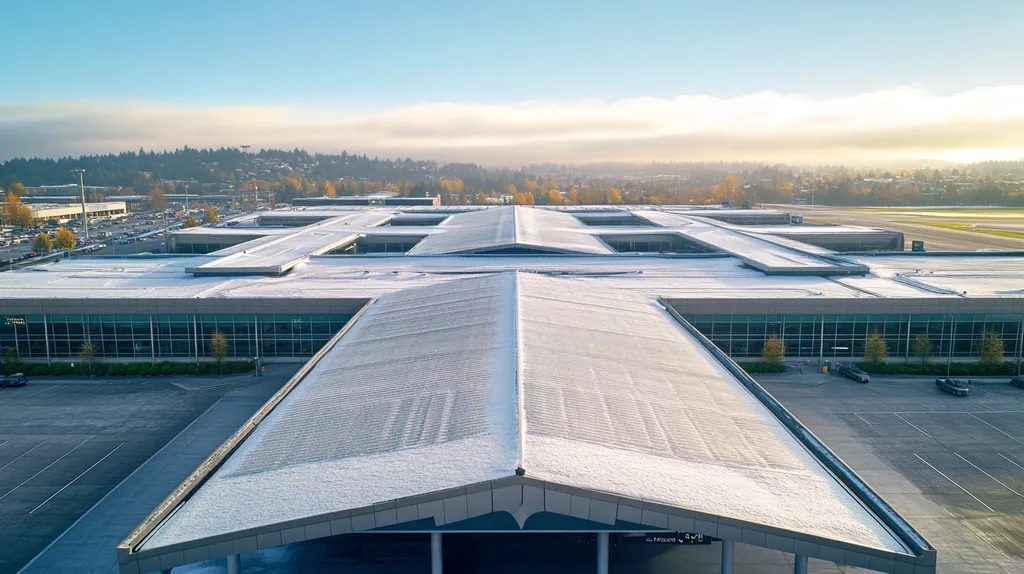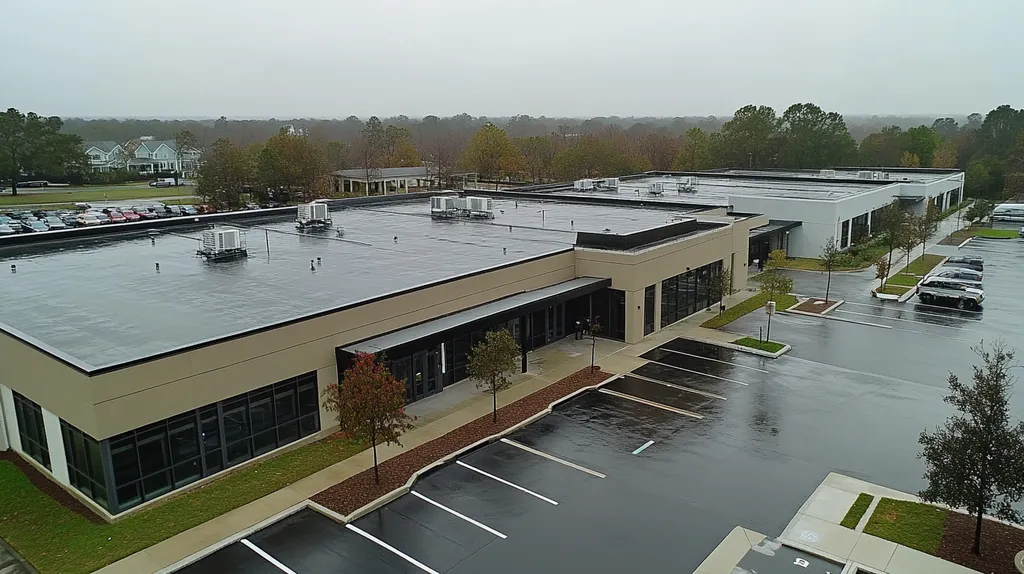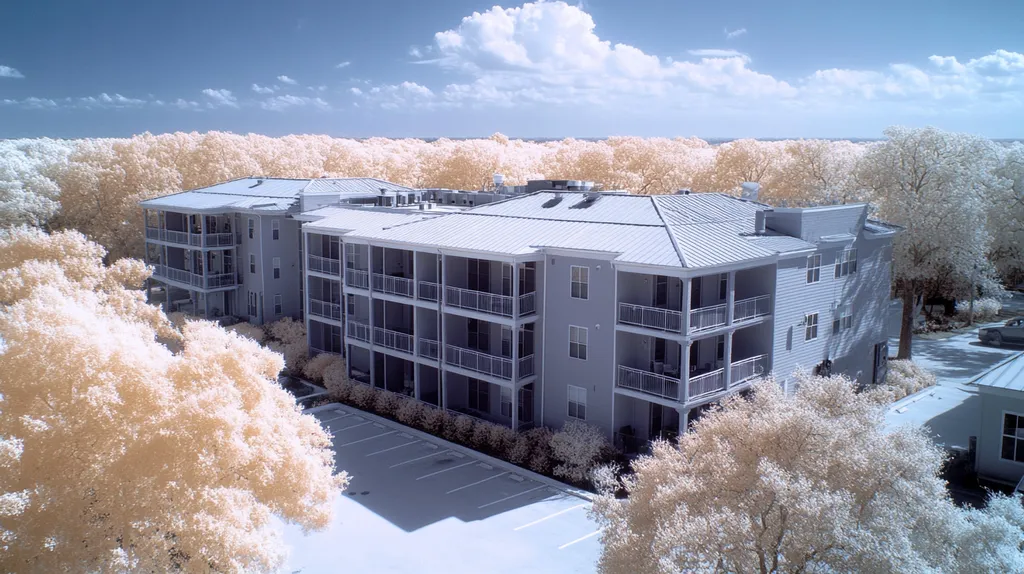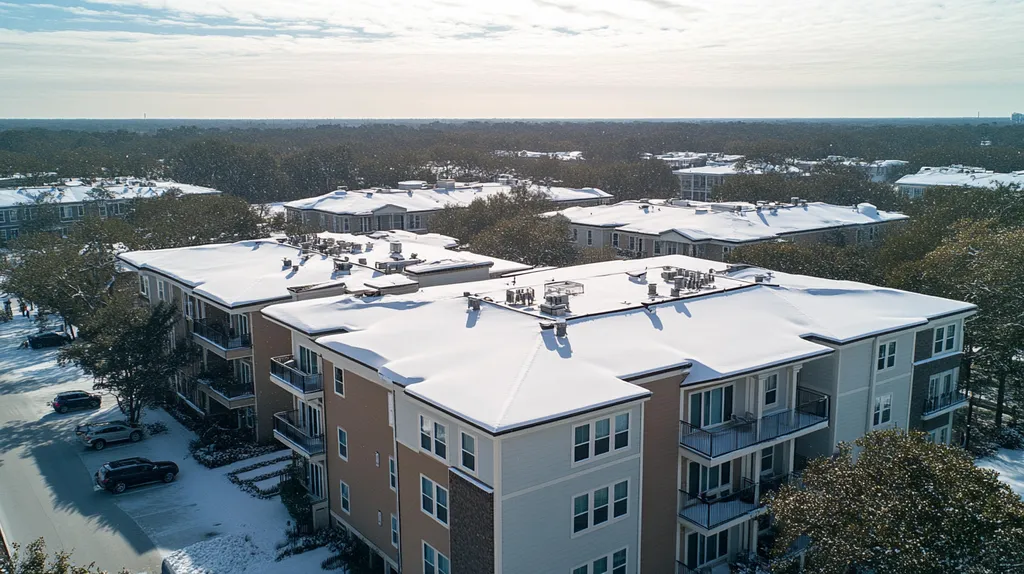Did you know that 80% of commercial roofs fail before their intended lifespan due to misunderstood or poorly managed warranties? This oversight costs property owners millions in premature replacements and emergency repairs each year.
Understanding how warranties determine a commercial roof’s longevity is critical for protecting your investment and avoiding costly surprises. Different warranty types, maintenance requirements, and coverage terms can dramatically impact a roof’s performance over time.
This comprehensive guide breaks down the essential factors that influence commercial roof lifespan through the lens of warranty management, equipping property owners with practical insights for maximizing their roofing investment.
SECTION 1: THE BASICS EXPLAINED
Understanding the lifespan of a commercial roof is essential for property owners and facility managers. Ignoring this critical element can lead to costly leaks, unexpected repairs, and even damage to the building’s structure. In fact, research indicates that neglectful roof management can slash a roof’s lifespan by up to 50%. This section simplifies how roof warranties operate and underscores their importance in protecting valuable investments.
What It Is (In Plain Language)
A commercial roof warranty is a promise from the manufacturer that guarantees roof performance for a specific period. Think of it as an assurance that the roofing materials will do their job—provided the owner commits to necessary maintenance. Warranties usually last between 10 to 30 years, and their specifics can vary based on materials and installation quality.
There are various types of warranties, including material warranties that focus on the roofing products and workmanship warranties that ensure the installation was done correctly. Understanding these distinctions is crucial for determining what is covered and what isn’t.
It’s also vital for property owners to differentiate between a warranty and a maintenance plan. While a warranty often stipulates that regular inspections and maintenance are needed to remain valid, knowing how to meet these requirements is crucial for the roof’s longevity.
In summary, a commercial roof warranty serves as an agreement detailing how long a roof can be expected to perform optimally under ideal conditions.
Why It Matters (To Your Building)
The lifespan of a commercial roof has a direct relationship with the overall health of a building and its operational costs. Neglecting warranty requirements can lead to severe issues like water damage and a drop in property value. When roofs fail prematurely, the financial repercussions can extend beyond simple repairs, impacting rental income and tenant satisfaction.
A roof that is well-maintained can even improve energy efficiency, leading to lower utility bills and a more comfortable atmosphere for occupants. For example, using reflective roofing materials can greatly reduce cooling costs, transforming the roof from a liability into an asset.
In addition, roofs that meet warranty conditions may qualify for discounts on insurance, as insurers recognize the reduced risks associated with well-supported roofing systems. This financial incentive highlights the importance of understanding and adhering to warranty terms for smart property management.
Ultimately, a roof’s lifespan influences everything—from operational costs to tenant retention—making compliance with warranty guidelines vital for maintaining property value.
How It Works
A commercial roof warranty operates based on specific terms and conditions set by the manufacturer. Each warranty outlines what is covered, how long the coverage lasts, and what responsibilities fall on the building owner. Gaining a clear understanding of these details is essential for ensuring the roofing system’s longevity.
Regular maintenance, such as scheduled inspections and prompt repairs, may be necessary to keep the warranty intact. Ignoring these requirements can void the warranty, leaving building owners exposed to costly repair bills.
Documentation is equally crucial. Keeping thorough records of inspections, repairs, and maintenance actions can be vital when filing a warranty claim. A structured approach to record-keeping can make the claims process smoother and more efficient.
Lastly, seeking advice from roofing professionals can help ensure that warranty obligations are met effectively. Engaging qualified contractors proactively can improve the long-term performance and extend the lifespan of the roof.
SECTION 2: PRACTICAL APPLICATIONS
Understanding the practical applications of commercial roof warranties is vital for property owners and facility managers. Failing to manage these warranties can lead to unexpected expenses and even jeopardize a building’s integrity. For example, neglecting maintenance can force a property owner to sink thousands into roof replacements, while a well-managed warranty might extend the roof’s life for decades. This section dives into real-world applications of roofing warranties, providing insights into common use cases, critical timing for claims, and interactions with other building systems.
Common Uses & Examples
Commercial roofs come in various forms, playing essential roles in protecting assets and supporting equipment. For instance, a flat roofing system is a popular choice for retail spaces due to its versatility. When maintained well and supported by a solid warranty, these roofs can far exceed their typical lifespan.
Warranties play a significant role here. Many contractors recommend warranties covering both materials and labor, often lasting from 10 to 20 years. Consider a single-ply membrane roof backed by a 20-year warranty; regular inspections and timely repairs can significantly enhance the roof’s durability.
Metal roofs have also gained traction due to their resilience. With warranties often stretching up to 30 years, they can be a wise investment for property owners. Adhering to manufacturer guidelines is key to ensuring these warranties remain valid and effective.
Ultimately, by understanding the various roofing systems and their warranty potential, property managers can maximize operational efficiency in their buildings.
When You Need It Most
The period immediately following a roof installation is particularly crucial for its longevity. Many potential issues align with this timeframe, making it a prime opportunity for utilizing warranties. Properties situated in areas with severe weather conditions, such as heavy rainfall or intense sunlight, are especially vulnerable.
For example, a storm may expose underlying weaknesses in roofing materials, highlighting the necessity for prompt repairs. Taking immediate action to file warranty claims during these emergencies can prevent expensive future issues.
Diligently tracking warranty details allows facility managers to respond swiftly when problems are detected. This proactive stance helps ensure that minor maintenance issues are addressed before they escalate into serious damage, potentially avoiding costly roof replacements.
Moreover, leveraging warranties during routine inspections can help maintain peak performance, resulting in long-lasting benefits for the facility.
Interactions With Other Systems
The roof is a critical component of a building’s overall efficiency, interacting directly with HVAC systems, ventilation, and drainage systems. Inappropriate drainage can result in standing water, which can degrade roofing materials more quickly than anticipated.
Facility managers should check that roof warranties include provisions about how other systems interact with the roof’s performance. For example, an improperly installed HVAC unit could potentially void a roof’s warranty, making it essential to ensure correct installation practices are followed.
Energy efficiency also hinges on the roof’s condition. A compromised roof can lead to soaring energy bills as heating and cooling systems struggle to maintain a comfortable environment. By utilizing warranties and adhering to the guidelines, property owners can foster better performance across all systems.
Ultimately, a solid grasp of these interactions can empower property managers to make better decisions, leading to enhanced long-term outcomes for commercial roofing systems.
SECTION 3: KEY TERMINOLOGY DECODED
Understanding essential roofing terminology is critical for property owners and facility managers. Misinterpretations can lead to costly mistakes and long-term headaches. In fact, recent studies show that 70% of roofing failures stem from misunderstandings of warranty terms. This section aims to demystify key terms and concepts that are vital for maintaining a roof’s lifespan and performance. By clarifying the language of roofing, stakeholders can make informed decisions that protect their investments.
Essential Terms Explained
When navigating the world of commercial roofing, terms like “life expectancy,” “warranty period,” and “material types” are frequently encountered. Life expectancy refers to the average duration a roofing system is expected to last under normal conditions, helping property owners understand what to anticipate. The warranty period defines the timeframe during which the manufacturer offers protection against defects, serving as a safety net for investments.
Different roofing materials, such as TPO, EPDM, metal, and built-up options, come with their own characteristics that affect durability and maintenance needs. Familiarizing oneself with these material types enables property managers to choose roofs that best suit specific environmental conditions and usage requirements. For instance, TPO roofs are celebrated for their combination of durability and energy efficiency, making them a favorite in commercial environments.
Industry Jargon Translated
The roofing industry has its share of jargon, but understanding terms like “reflectivity,” “punctured warranty,” and “substrate” is crucial for making sound decisions. Reflectivity describes how well a roof deflects sunlight, which can significantly impact energy costs. Higher reflectivity often leads to reduced cooling expenses, especially in regions that experience intense sunlight.
A punctured warranty occurs when damage isn’t properly addressed, voiding the warranty’s benefits. This reality highlights the importance of diligent maintenance to keep warranties valid. The term substrate refers to the base layer of roofing material that supports the entire system. Knowing the type of substrate helps facility managers comprehend the installation process and ensures long-term roof performance.
Understanding these terms minimizes the risk of misunderstandings and empowers property managers to navigate roofing decisions more effectively.
Measurement & Units Simplified
Precision in measurements and units is essential for making informed roofing decisions. Square footage is a critical measurement since roofing materials are generally sold by the square or bundle, differing by material type. One square equals 100 square feet, which is vital for budgeting and ordering supplies accurately.
The term “mil” is another key measurement you’ll encounter. It represents the thickness of roofing materials, particularly membranes, where one mil equals one-thousandth of an inch. Thicker materials typically offer increased durability and lifespan, making this a significant factor to consider.
Lastly, the slope of the roof—its steepness—can greatly affect drainage and material selection. Different degrees of slope necessitate customized approaches for installation and maintenance. By breaking down these measurements and units into more digestible concepts, property managers can enhance the roof installation process and ensure best practices are followed.
SECTION 4: DECISION FACTORS
Choosing the right roofing system is a critical decision for property owners and facility managers, with stakes that can significantly affect a building’s long-term performance. A poor choice may not only lead to immediate costs but can also compromise the structural integrity of the entire property. Shockingly, studies show that nearly 50% of commercial roofs fail prematurely due to overlooked decision factors. Key considerations include costs, performance trade-offs, and the durability of the materials. Understanding these elements can empower property managers to make informed decisions that secure their investments.
Cost Considerations
Cost is often the first factor weighing on property owners when selecting a roofing system. Initial installation costs can vary widely, influenced by the choice of materials and labor expenses. However, concentrating solely on upfront pricing can be misleading and may invite future financial headaches.
Higher-priced materials often provide better durability and extended warranties. For example, while a TPO membrane might have a lower initial cost compared to a built-up roof, its potential longevity and minimal repair requirements may offer greater value over time.
It’s also essential to consider ongoing costs, including regular maintenance and potential repairs, which can accumulate over a roof’s lifespan. Ignoring these factors can lead to unexpected financial burdens down the line.
Additionally, energy efficiency and insurance implications should factor into the overall cost equation. Opting for roofing systems that promote energy savings can help mitigate long-term expenses, ultimately enhancing overall financial performance.
Performance Trade-offs
The performance characteristics of roofing systems significantly influence their effectiveness. When evaluating options, trade-offs may arise regarding insulation, reflectivity, and durability.
For instance, selecting a highly reflective membrane may improve energy efficiency, yet its performance in extreme weather conditions could be compromised. Balancing these various characteristics can be a complex challenge.
Moreover, not every roofing system is equipped to handle all environmental conditions. Factors such as wind, heavy rains, or extreme temperatures should align with local weather patterns to avoid premature failures.
Overlooking these performance trade-offs can result in increased operational costs and reduced system longevity. Thoughtful evaluations can help ensure that the chosen roofing solution meets performance expectations throughout its lifespan.
Lifespan & Durability Factors
The expected lifespan of a roofing system is largely determined by its overall durability. Understanding warranty specifics is key to assessing this aspect effectively.
Generally, roofing materials that offer longer warranties are indicative of greater durability. A 20-year warranty typically suggests higher quality materials compared to a 10-year warranty, reflecting manufacturer confidence in the product.
Local environmental factors, such as UV exposure and moisture levels, profoundly impact material durability. Choosing a roofing system designed to withstand local conditions increases the likelihood of an extended lifespan.
Regular inspections and consistent maintenance are also pivotal for prolonging any roof’s life. Neglecting these practices can trigger significant issues that truncate a roof’s lifespan, highlighting the importance of proactive management strategies.
SECTION 5: COMMON CHALLENGES
Understanding the challenges that can arise with a commercial roof is vital for property owners and facility managers. Without regular maintenance and timely repairs, seemingly minor issues can escalate into significant problems that result in costly repairs or even total roof replacement. In fact, research reveals that neglecting small roofing issues can shorten a roof’s lifespan by up to 25%. This section dives into common challenges encountered in commercial roofing and provides practical solutions.
Frequent Problems & Solutions
One common challenge faced by commercial roofs is water pooling, which can quickly lead to leaks and structural damage. This problem often arises in low-slope roofs where drainage systems may struggle to handle excess water. Conducting regular inspections can catch these issues early, allowing for the implementation of improved drainage solutions and surface repairs, thus safeguarding against extensive damage.
Membrane deterioration from UV exposure is another prevalent issue. Materials like TPO and PVC can suffer from breakdown over time due to sunlight. An effective solution is applying a reflective coating, which not only extends the membrane’s life but also helps reduce energy costs related to cooling the building.
Punctures and tears are also frequently overlooked during maintenance tasks. These can occur from foot traffic or debris on the roof surface. Addressing these small damage spots with appropriate patching materials quickly can prevent them from developing into larger leaks that are more costly to repair.
To combat these frequent issues, establishing regular maintenance schedules with experienced contractors is crucial. Scheduled inspections align with best practices and help identify vulnerabilities before they escalate, ultimately improving the roof’s overall performance.
Warning Signs To Watch For
Identifying warning signs early can save property owners from significant repair costs. One major warning sign includes water stains appearing on ceilings or walls. These stains can indicate roof leaks that may have already jeopardized the building’s interior. Conducting timely inspections can help trace these stains back to underlying roof issues.
Blistering of the roofing membrane is another troubling indicator. These blisters can signify trapped moisture, potentially leading to membrane failure. If property managers notice this issue, they should arrange for immediate inspections, as early intervention can prevent extensive damage down the line.
Excessive granule loss in asphalt roofs signals aging, too. If owners observe a build-up of granules in gutters or downspouts, it implies the roof may be nearing the end of its effective lifespan. Proactive measures, such as discussing re-coating or replacement options with roofing professionals, can be vital in maintaining the roof’s integrity.
Visible sagging or warping of roof sections should raise red flags as well. Such structural issues can threaten building safety and necessitate immediate assessment by roofing experts.
Preventative Approaches
A well-defined maintenance plan is the best defense against roofing challenges and can substantially extend a roof’s lifespan. Regular inspections, ideally scheduled twice a year, can enable property owners to identify and tackle small issues before they escalate into major complications. Keeping documentation of these inspections is beneficial for tracking roof performance over time.
Employing professional roofers experienced in commercial systems can make a notable impact on the effectiveness of treatment measures. These experts can provide valuable insights and recommend top-notch products suited for specific roof types.
Utilizing high-quality roof coatings is another proactive strategy that can protect against weather damage and harmful UV rays. Not only do these coatings extend the lifespan of a roof, but they also enhance energy efficiency, reducing overall cooling costs for the property.
Lastly, educating building personnel on the warning signs of roofing problems is critical. Training staff to promptly recognize and report issues allows for swift action, fostering a culture of roof care that ultimately protects the investment made in the building.
SECTION 6: NEXT STEPS & RESOURCES
Understanding commercial roof warranties is crucial for property owners and facility managers. A well-informed decision regarding warranties can prevent unexpected repair costs and ensure that the roofing system performs as expected. Without this knowledge, roofs may fail prematurely, jeopardizing both finances and safety. This section highlights important questions to pose to providers, outlines industry standards to keep in mind, and provides resources for further educational opportunities.
Questions To Ask Providers
Property owners should come prepared with specific questions when discussing warranties with roofing providers. First, clarify what exactly the warranty covers; warranties can differ widely in terms of materials and workmanship assurances.
Next, ask how long the warranty lasts and what conditions could void it. Some warranties may initially appear extensive but could have hidden clauses that reduce coverage.
It’s also crucial to understand how the warranty claims process works. Knowing what steps to take for maintenance and repairs can save time and money in the long run.
Lastly, request references or examples of past projects that have been successfully covered under similar warranties. This can shed light on the provider’s reliability and customer service standards.
Industry Standards & Guidelines
Focusing on industry standards is essential for ensuring the longevity of a commercial roof. The National Roofing Contractors Association (NRCA) provides guidelines that promote best practices for both installation and maintenance, which is key to a roof’s durability.
Property owners should also familiarize themselves with the American Society for Testing and Materials (ASTM) standards. These benchmarks guide the quality of roofing materials and assess their performance.
By adhering to these established standards, property owners can not only safeguard their investments but also ensure compliance with local building regulations. Non-compliance can lead to costly fines and the need for remedial work.
Ultimately, understanding these guidelines helps facility managers advocate for quality roofing solutions that align with performance expectations throughout the roof’s lifecycle.
Further Learning Simplified
Staying educated about roofing systems is vital for effective property management. Numerous online resources, including webinars hosted by roofing organizations, provide valuable insights into warranties and new technologies in the industry.
Industry publications and trusted roofing websites offer articles that break down complex roofing topics into simpler concepts, keeping property owners updated on the latest trends and standards.
Attending trade shows and seminars is another excellent way to gain knowledge. Networking with industry professionals can clarify questions and reveal effective solutions for roofing challenges.
Lastly, seeking advice from a roofing consultant can provide personalized insights tailored to specific property needs. This investment can lead to significant advantages in maintaining a robust and lasting roofing system.
The Bottom Line
With up to 80% of commercial roofs failing prematurely due to warranty mismanagement, understanding how warranties determine roof lifespan is more critical than ever.
Regular maintenance, proper documentation, and adherence to warranty requirements can extend a roof’s life by 25-40% while protecting against costly repairs and replacements.
Property owners must recognize that warranties are not just paperwork, but vital tools that directly impact building performance, energy efficiency, and long-term operational costs.
By implementing the strategies outlined in this guide and staying informed about warranty requirements, facility managers can maximize their roofing investment and ensure optimal protection for their commercial properties.
The time to act is now – your roof’s longevity depends on it.
FREQUENTLY ASKED QUESTIONS
Q. What is the lifespan of a commercial roof?
A. The lifespan varies significantly based on materials and maintenance. Generally, commercial roofs last between 10 to 30 years. Proper upkeep can significantly extend these estimates, protecting your investment over time.
Q. How do warranty terms impact an industrial roof?
A. Warranty terms detail coverage duration and maintenance responsibilities for your roof. A well-managed warranty can prevent costly repairs and extend your roof’s lifespan, ensuring maximum protection for your building.
Q. What are common uses of a commercial roof warranty?
A. Warranties protect against defects in materials and installation. They are commonly used for claims related to leaks or material failures. Understanding your warranty’s coverage can save substantial costs associated with repairs and replacements.
Q. What factors affect the decision for a commercial roof?
A. When deciding on a roof, consider costs, performance, and material durability. Each roofing system comes with trade-offs that impact long-term performance. Balancing initial expenses with future savings is vital for selecting the right option.
Q. What are common challenges with an industrial roof?
A. Frequent challenges include water pooling, UV damage, and punctures. Addressing these issues early with regular inspections is crucial to prevent minor problems from escalating into costly repairs.
Q. What questions should I ask about a commercial roof warranty?
A. Ask what is covered, how long the warranty lasts, and claim procedures. Understanding these details ensures that you are prepared to maintain your roof effectively and maximize its warranty benefits.
Q. How can building owners ensure roof longevity?
A. Regular inspections, timely repairs, and adherence to maintenance guidelines can significantly extend the life of your roof. Training staff to recognize warning signs also enhances proactive management of your roofing system.











